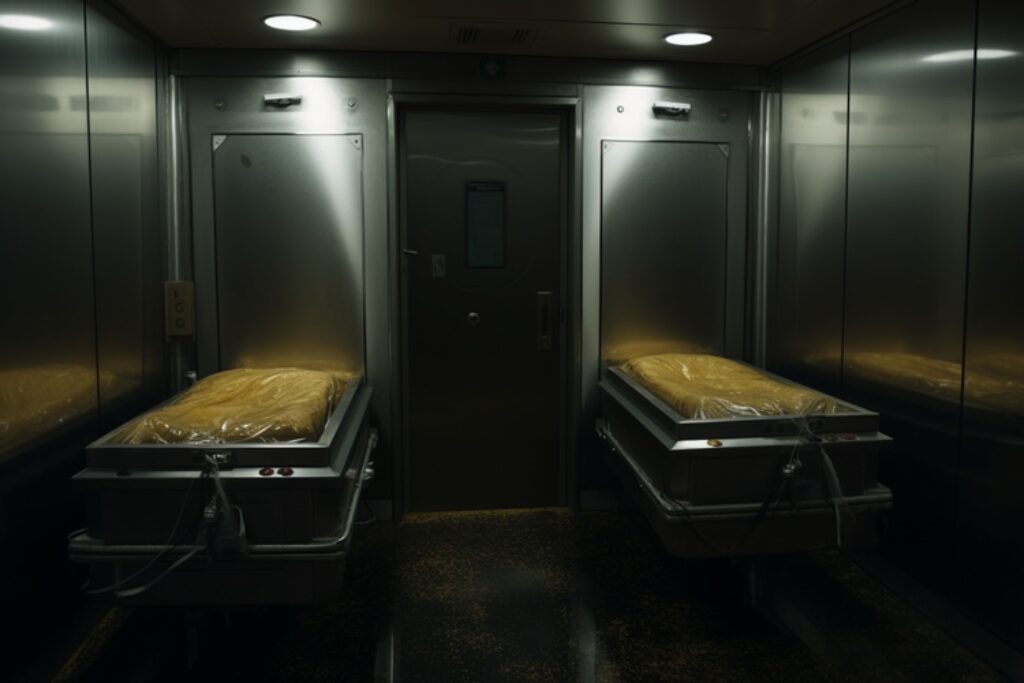
The Cremation Process Demystified: What Happens Behind the Scenes
As cremation continues rising as the preferred option for over 75% of British families today, it remains a mysteriously unseen ritual to most. This step-by-step journey through its intimate procedures aims to enlighten and reassure.
Related Topics (Sponsored Ads):

Arriving for the Final Farewell
The recently departed’s body is delivered to the crematorium inside a sturdy yet combustible coffin or casket specifically designed to fit seamlessly into the cremation chamber. Before further handling, staff carefully remove any protruding exterior fittings like handles, nails or metal embellishments that may scratch the chamber’s interior once exposed to high heat. Identification tags are attached to verify and confirm the identity of the individual throughout the entire process until handed back to loved ones.
Honoring Their Spirit: The Cremation Service
Prior to the physical cremation, a memorial service reflects religious, cultural or personal preferences to honor the deceased’s life. This may include special music, prayers, readings of meaningful poems or faith-based texts, or intimate eulogies from loved ones remembering the individual’s legacy. Floral arrangements adorn their closed casket while the tribute unfolds. When ending, the coffin passes through curtains or mechanical doors, symbolically beginning a transition from the world of the living to that of the departed.
Encased in Fire: Inside the Cremation Chamber
The casket is slid directly into the cremation chamber, made up of thick, heat-resistant bricks with an entrance door that tightly seals shut. Thanks to strict environmental regulations, cremators today have advanced secondary burning chambers and special filters eliminating past issues with smoke emissions. Once locked inside, separate fuel sources ignite and raise the temperature to exceptional highs ranging from 1400-1800 degrees Fahrenheit, engineered specifically to fully cremate an average adult human body within a reasonable timeframe of 1-2 hours. The instant the coffin enters, this extreme heat triggers flash ignition
Behind Closed Doors: Cremation Phase by Phase
While the precise technology has been perfected over decades, the process of human cremation itself is quite simple, using only heat and air to reduce the body to basic compounds in distinct stages occurring just out of sight:
- Vaporization Phase: Intense temperatures between 1400-1800°F soon vaporize all body fluids and melt fatty tissues which burn off and dissipate into the air rather rapidly.
- Organic Burning Phase: With body fats and fluids evaporated, soft tissues like skin, muscles and organs now ignite and begin slowly carbonizing.
- Skeletal Decalcification Phase: Bones start progressively drying out and becoming more fragile and brittle.
- Disintegration Phase: The now extremely fragile skeleton structure eventually crumbles and disintegrates into small, chalky bone fragments.
Powerful, precisely controlled flows of hot air circulate inside the chamber for the duration required to reach and break down every area, reducing what was once human remains into mostly unidentifiable elemental compounds. Any metals like hinges, screws, pins and other non-combustible hardware from casket fittings or medical implants will have melted and collected into a discrete pile beneath the floor grating to be removed later.
Assembling the Ashes: The Final Steps
With the organic cremation fully complete, the resulting cremated remains (also referred to as “cremains” in the industry) have had ample time to fully cool inside the now shut-down machine. These cremains account for only roughly a quarter of the original body volume, averaging 4-8 pounds. Surprising to most, they resemble coarse sand or gravel, with subtle hints of white ash from bone. Any singular bone fragments still visible at this stage are separately swept out and placed into a processor called a cremulator. This machine pulverizes them into fine particles to achieve a smooth, consistent texture similar to ash. Carefully pouring this processed material into the selected urn completes the cycle.
If dividing up the ashes amongst multiple loved ones or scattering in several locations for any reason, staff will ensure smooth, equal splits and provide the appropriate smaller vessels. The necessary legal paperwork is also finalized by crematorium staff before the remains are officially released back to the family.
Unique & Meaningful Options for Ashes
Today there are more options than ever to memorialize cremated ashes into distinctive keepsakes. Ashes can be custom incorporated into specially designed objects like striking jewelry pieces, elaborate hand-blown glass artwork, or colorful works of pottery. For those whose passions stretched to the farthest corners of our planet and even beyond into galaxies unknown, a few enterprising spaceflight companies now offer services to rocket up symbolic portions of cremains past Earth’s orbit or to the surface of the moon and deep space.
Methods like aquamation or resomation use water instead of direct burning to naturally dissolve remains into bone ash while avoiding ecological impacts associated with fire. These alternative green methods allow families the comfort of retaining ashes afterwards for ritualistic purposes in spreading or burial if desired. The wide range of options demonstrates how more personalized choices than ever exist to create a meaningful farewell.
Finding Closure Through Understanding
While most crematoriums do not offer public viewing due to safety, some do allow small gatherings of immediate family to safely observe the initial casket placement from a protected area. Witnessing this transition firsthand and knowing each precise step of the process can provide grieving families further closure and reassurance during difficult times. Seeing that staff treat the body with utmost care and dignity throughout shows cremation’s purpose is not merely expedient disposal but honoring physical remains as vessels of the eternal soul.
As cultural attitudes towards death and spirituality evolve over generations, cremation has emerged as the preferred farewell ritual for modern British families from all walks of life. Its efficiently condensed timeline compliments today’s busy pace without sacrificing meaningful closure. Additionally, the wide range of memorialization options for ashes resonates with bygone ancestral practices across all spiritual roots and customs. Most importantly though, by enlightening the public on the real process behind the mystique, families gain peace and can fully celebrate their loved one’s life knowing the process undertaken honors both past and present.
Related Topics (Sponsored Ads):
Discover More






